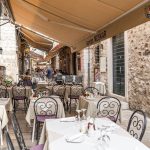The 2022 tourist season should be excellent and at the level of 2019 or even better, at least according to the announcements. After two pandemic years, lockdowns have been lifted across Europe, and tourists are coming back to Croatia. But will there be enough seasonal workers to fill all the necessary jobs? Index.hr reports:
According to the eVisitor system, which includes tourist traffic generated in commercial and non-commercial facilities and nautical charter (eCrew), in Croatia during the Easter holidays, i.e., from Friday, April 15, to Monday, April 18, 2022, there were about 135,000 arrivals and about 493,000 overnight stays. That’s far better than last year’s 147,000 overnight stays in the same period.
By default, most guests are in Istria and Kvarner, followed by Split-Dalmatia County. Arrivals in Dalmatian cities are the most frequent, though Zagreb has achieved the most overnight stays of all cities in Croatia. Looking at the entire country, almost the same number of overnight stays has been recorded since the beginning of the year as the record in 2019.
The latest research, “Monitoring the Sense of Domestic and Intra-European Travel – Wave 11” by the European Travel Commission (ETC), shows that Croatia, whose economy depends mainly on tourism, has something to look forward to. According to the research, three out of four Europeans intend to travel in the next six months, and the most attractive are Mediterranean destinations, including Croatia. According to the same research, holidays in the sun and the beach are the most desirable option, preferred by more than a fifth (22 percent) of Europeans.
These numbers will also increase the need for seasonal workers in tourism. According to the Croatian Employment Service data, 31,547 seasonal workers were sought in 2019, and 28,697 of them were employed from the Employment Service records.
How bad the pandemic was in 2020 for tourism is shown by only 18,380 workers sought through the Institute and 21,031 employees. The actual number is much higher because not all seasonal workers from the Institute are employed, but the trend is essential. Waiters, maids, cooks, cleaners, salespeople, kitchen workers, and assistant chefs are most in demand.
In the last few years, the lack of workers in Croatia has become a problem. After a decade of employers’ attitude, “if you don’t want to work for this salary, there are ten of them at the Bureau who will,” workers have gained more negotiating power. Now they are in a position to demand better working conditions from employers.
The average salaries of seasonal workers are lower than the average salaries in the rest of the economy. For example, according to information from MojPosao, it ranges from HRK 4,427 (net) for a maid to HRK 6,306 (net) for a cook.
Emigration to the EU contributed the most, with economic recovery after a long crisis. In 2013, 345 thousand unemployed people were registered in Croatia, and in 2019, 2.7 times less, or 128 thousand. The potential labor pool has shrunk drastically; bargaining power has shifted from employers to workers. There are currently 121,000 unemployed in Croatia, and 78,000 jobs have been created at the CES.
“The labor shortage problem, which has been present for many years, culminated this year. There is no labor force needed for the tourist season in our country. Slavonia, which was an inexhaustible source of quality catering staff, unfortunately, is no longer, but of the total number of employees, most are still from that region. We educated them at the expense of the Croatian state budget to now work for Austrians, Germans, Irish, where their salaries are twice as high as in Croatia,” said Eduard Andrić, president of the Croatian Trade Union of Tourism and Services.
For the first time in Croatian history, employers need workers more than workers need them. The highest quality staff mostly moved to the west of the EU, so there was a labor shortage in Croatia. Most low-skilled workers left, so the lack of such workers is the largest. As a result, the wages of the lower-paid grew faster than the high wages, at least until the beginning of the pandemic. According to MojPosao, waiters are the most sought-after workers in Croatia, followed by traders, chefs, warehouse workers, drivers, and developers.
“The number of missing workers in tourism ranges from 30 to 35 thousand. We are looking for cleaners, maids, waiters and assistant waiters, chefs, assistant chefs, cooks, and receptionists. Salaries range from 4 to 9 thousand, and some staff who have gross contracts receive significantly higher salaries,” Andrić specifies.
In addition to offering better working conditions to encourage the local population to work, the shortage of workers in Croatia must be compensated by importing labor. The fact that employers in Croatia have to look for workers abroad because there are not enough of them in Croatia or they do not want to work under the conditions offered by employers is a historical novelty.
In 2021, 66,917 applications were submitted in Croatia to issue work permits to foreigners, primarily for construction occupations and seasonal jobs, such as chefs, waiters, bakers, and cleaners. In the first three months of 2022 alone, 32,863 applications for work permits were submitted, which signals that far more applications will be submitted by the end of the previous year.
The most sought-after occupations with a request for temporary work in the first three months of 2022 are cooks (1829), maids (1780), assistant cooks (1465), assistant waiters (932), bakers (679 ), hotel maids (155), pastry chefs (149) and receptionists (48). For approved applications, the average gross salary of foreign workers in tourism is between HRK 4,700 and HRK 5,700.
“Workers from our neighboring countries, such as Serbia, Macedonia, Kosovo, or Bosnia and Herzegovina, go where our workers go, so we can’t count on a large number of these workers. When they are already leaving their countries, it is the same for them whether they will come to Istria or go to Austria, and in Austria, they will receive twice the salary. After the liberalization of labor imports, employers turned to the markets of the Philippines, India, Ukraine, and even Russia. However, the war in Ukraine prevented the arrival of the agreed labor force from that country and the labor force from Russia,” Andrić claims.
Emigrants from Ukraine might be able to fill a hole in the market, but that won’t be even close enough. Ukraine has banned men from leaving the country, so the emigrants are primarily women and children. According to the latest information, there are currently about 11,000 refugees from Ukraine in Croatia, of which 30 percent are highly educated.
All persons who have the status of a foreigner under temporary protection in Croatia can register in the unemployment register of the Croatian Employment Service if they want help and support. The CES produced a leaflet in the Ukrainian language and the Cyrillic alphabet. The leaflet can contain all the information on registration in the unemployment register and the rights that a person exercises after registration.
CES individual advisers provide support to highly educated Ukrainians in filling out applications to recognize higher education qualifications, which is the responsibility of the Agency for Science and Higher Education. When asked about the number of Ukrainian refugees employed in Croatia, the CES said that by April 15, 355 employers had expressed interest in employment, 494 people had registered with the Croatian Employment Service, and 42 had registered. employed through CES mediation.
“We should keep in mind that people under temporary protection are mostly women with minor children enrolled in education or kindergarten. There is a problem with their temporary relocation and temporary accommodation in Adriatic counties during the tourist season. Most employers, especially large hoteliers, have no infrastructure and the possibility of accommodating minor children, making it more difficult for them to be employed on a large scale during the season,” the CES notes.
The announcement of a good tourist season is good news because tourism is the backbone of a large part of the Croatian economy, state revenues, and household budgets, whether by renting, added activities, or seasonal work.
What happens to Croatia when tourism disappears is shown by the pandemic in 2020, when Croatia had one of the most significant falls in GDP in the EU, at over 8 percent. There was no increase in prices that year as this year. Inflation has officially exceeded 6 percent, and if the trend continues, it could reach 10 percent by the end of the year.
Any income from tourism is saved for the Croatian economy and citizens in such conditions. And for good results, workers are needed.
For more, check out our dedicated business section.












